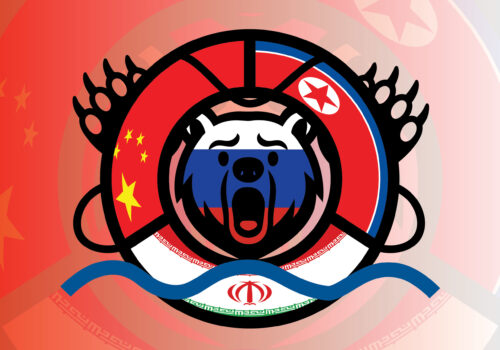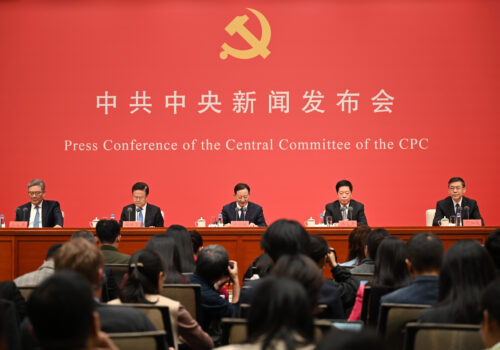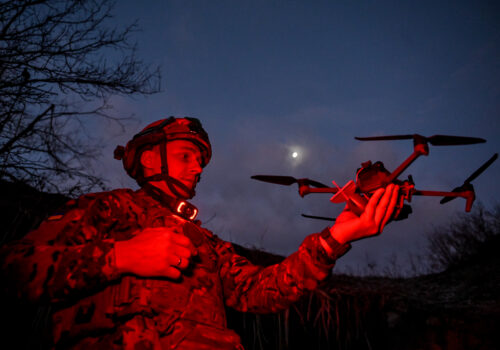Trump’s place in history depends on his approach to the CRINK
During his first nine months in office, US President Donald Trump has secured a string of foreign policy wins that have the potential to be historic. Even some of his fiercest critics give him credit for these breakthroughs. But the more significant challenge awaits in the weeks ahead. It concerns how Trump manages the more complex and higher-stakes challenges from great-power rivals China and Russia—and the intertwined nature of those adversaries.
But first, the good news.
In the Middle East, the Trump administration engineered a Gaza deal that brought home the last of the living hostages held by Hamas and set out a phased approach to a more lasting peace. That, in turn, could result in greater economic and security integration in the Middle East, built on the Abraham Accords, leading to the normalization of diplomatic relations between Israel and Saudi Arabia.
Trump’s attacks against three Iranian nuclear facilities in June contributed to that effort by decisively striking at the region’s primary spoiler of broader Middle East peace and integration. He restored regional deterrence and signaled that the United States would act rather than simply threaten when Tehran demonstrated that it wasn’t ready to negotiate. A few days later, in The Hague, Trump’s leverage resulted in European allies pledging to increase their defense and defense-related spending to 5 percent of gross domestic product by 2035. Trump’s critics had worried that he would destroy NATO, but thus far he has served to strengthen it.
Now, the less positive news.
What remain unresolved are Trump’s most consequential foreign policy challenges: those he faces with Russia and China. Unless Trump recalibrates on both and treats Moscow and Beijing as part of a linked strategic front—continuing to offer credible engagement but applying more sustained pressure—history will judge him more for what is still unfinished than what he has achieved.
Dealing with Russia and China will require greater creativity, negotiating skill, strategic thinking, and cooperation with allies than has been achieved thus far.
United by shared grievances
Trump’s allies have argued that he deserves the Nobel Peace Prize for the contributions he has already made to peace-making. That will be a matter for the five-person Norwegian committee that passed over him this year. But far more significant than any annual prize ceremony is the generational battle over which countries and forces will shape the global future. That will depend in no small part on how the United States and the Trump administration, working alongside allies, address the gathering threat posed by China, Russia, Iran, and North Korea, increasingly known as the CRINK.
“Russia’s war against Ukraine has brought it a new set of partners,” writes Angela Stent in a significant Atlantic Council report aimed at how the West should address this new challenge. “While this group is sometimes referred to as an axis, in reality it is a set of intensifying bilateral ties with countries—China, Iran, and North Korea—that are essential for Russia’s continued prosecution of the war.” She notes that these countries are committed to create a new world order and “increasingly constitute an anti-US bloc, united not by shared values but by shared grievances.”
On the Russia front, this past week brought good news in that Trump scrapped plans for a Budapest summit with Russian President Vladimir Putin, ratcheted up economic sanctions on Russia, and appears to have taken measures that would help Ukraine militarily. Taken together, these actions seem to reflect Trump’s greater recognition that the peace he desires won’t happen until Putin pays a higher military and economic price for continuing the war.
What Trump reportedly did this week is ease restrictions on how Ukraine can use long-range missiles provided by Western allies for attacks inside Russia, which top Ukrainian officials believe could be a game-changer in allowing them to strike key military targets such as the Russian manufacturing facilities for armed drones and ballistic missiles that are killing their civilians. (On his Truth Social platform, Trump responded to the Wall Street Journal’s scoop regarding the policy change by denying the report and saying: “The U.S. has nothing to do with those missiles, wherever they may come from, or what Ukraine does with them!”) Trump also announced the first US sanctions on Russia’s two largest oil companies, Lukoil and Rosneft, alongside some three dozen of their subsidiaries.
The Wall Street Journal also reported that the Trump administration has transferred authority for approving such strikes from Secretary of War Pete Hegseth, who European and Ukrainian officials have told me has been unwilling to provide his green light, to General Alexus Grynkewich, NATO’s supreme allied commander Europe, who better understands battleground realities. How these changes translate into practice remains to be seen, but the needle is moving in the right direction.
Before this past week’s shift on Russia, Washington Post columnist Max Boot compared Trump’s relationship with Putin to the famous Charles Schulz comic strip Peanuts, where “for decades, Lucy van Pelt would encourage Charlie Brown to kick the football—and every time she would yank it away just before his foot connected, sending him sprawling . . . Putin is Lucy, Trump is Charlie Brown, and peace in Ukraine is the football.”
Charlie Brown never did wise up, but the past week’s news shows that Trump may have grown tired of Putin’s manipulation and humiliation. One can only hope that Trump has begun to take the advice of Marc Thiessen, another Washington Post columnist, whom Trump is known to follow.
“President Donald Trump struck a Middle East deal by following a simple strategy: Do the opposite of what Joe Biden did,” wrote Thiessen recently. “The same approach will help him bring peace to Ukraine.”
Thiessen argues that Hamas and Putin have a couple of important traits in common: Neither intends to voluntarily give up their wars on their enemies, and both require the application of greater military pressure than Biden would countenance. Thiessen noted that Trump gave Israel the weapons that Biden withheld, forcing Hamas to the table. He argued that Trump should do the same with Putin “by imposing unsustainable military and financial costs on Russia.”
“Be nice to your allies“
When it comes to China, Trump’s transactional style, reliance on tariffs, and eagerness to make deals bumps up against President Xi Jinping’s ambition for global supremacy, negotiating leverage stemming from his control of critical minerals, and willingness to wait out Trump (confident he holds the better cards).
Hu Xijin of the Global Times, who is thought to reflect official thinking, said on X that China’s recent restrictions on critical minerals constituted “a turning point.” Hu went on: “The sense of being strangled that the US feels today from China’s rare earth export controls is exactly like the one China experienced in 2018 when the US cut off chip supplies . . . The turning point is that the US needs to respect China’s national interests, especially our core interests . . . not with the high-handed arrogance of the past.”
On Sunday, negotiators for China and the United States announced that they had agreed to a framework of a deal on critical minerals and tariffs, ahead of the leaders’ meeting on Thursday. But the details are not yet final.
As he makes the rounds this week in Asia, Trump would be able to exert more leverage with both China and Russia if he understood how consistently they are working together as the key players in the CRINK and if he more intentionally embraced what neither of them enjoys: treaty allies.
The closest Trump has come to acknowledging that he is facing an axis of aggressors scheming against the United States was in September, during a Beijing parade and celebration bringing together Chinese, Russian, Iranian, and North Korean leaders. In a Truth Social post addressed to Xi, Trump wrote: “Please give my warmest regards to President Vladimir Putin, and Kim Jong Un, as you conspire against the United States of America.”
In a conversation last week at the Atlantic Council, Global China Hub Senior Director Melanie Hart asked former US Ambassador to China Nicholas Burns what advice he would give Trump ahead of his scheduled meeting this week in South Korea with Xi on the margins of the Asia-Pacific Economic Cooperation summit.
“First of all, we can never underestimate the capacity of the government of China and their ambition” to be the strongest power in the Indo-Pacific, said Burns. Second, Trump must disabuse China of the notion that the United States is “yesterday’s power” and is in decline. Third, one can’t negotiate on trade and lose sight of military and technological competition with China. Finally, and most importantly, Burns advised Trump to “be nice to your allies.”
Burns continued, “the United States is the leader of these two great alliances, our treaty allies in the Pacific and NATO in Europe, and we can deploy those alliances effectively to limit Chinese power.” He warned, however, that developing a common response to China is more difficult given Trump’s tariff policies aimed against allies and partners, including a new 50 percent tariff on India, and repeated questioning of the sovereignty of allies. One of those allies is Canada, which Trump targeted with a new 10 percent tariff over the weekend amid a dispute over a Canadian anti-tariff television ad.
Historians might look back at the Trump administration with praise for many of its foreign policy accomplishments but with questions about whether it missed addressing the larger threats presented by Russia and China—and their generational consequences. A Nobel Peace Prize-worthy breakthrough with those countries would require shifting from striking deals of the moment to embracing allies, recognizing the dangerous links among adversaries, and executing a consistent strategy to counter those adversaries.
Frederick Kempe is president and chief executive officer of the Atlantic Council. You can follow him on X @FredKempe.
This edition is part of Frederick Kempe’s Inflection Points newsletter, a column of dispatches from a world in transition. To receive this newsletter throughout the week, sign up here.
Further reading
Thu, Oct 23, 2025
The CRINK: Inside the new bloc supporting Russia’s war against Ukraine
Issue Brief By
The latest report in the Atlantic Council's Russia Tomorrow series details how Russia’s war against Ukraine has brought together a new set of partners--united not by shared values, but by shared grievances--on the international stage: China, Russia, Iran, and North Korea.
Fri, Oct 24, 2025
The winners and losers from China’s next five-year plan
New Atlanticist By Jeremy Mark
In Beijing, the Chinese Communist Party’s Central Committee met this week to move forward the country’s fifteenth five-year plan.
Fri, Oct 10, 2025
Dispatch from Ukraine: The path to a durable peace is emerging
Inflection Points By Frederick Kempe
A recent trip to Kyiv reinforced that, as momentum shifts in Ukraine’s favor, a just and durable peace could be within reach.
Image: Russian President Vladimir Putin, Chinese President Xi Jinping, North Korean leader Kim Jong Un and heads of foreign delegations arrive for a military parade marking the eightieth anniversary of the end of World War II, in Beijing, China September 3, 2025. Sputnik/Sergey Bobylev/Pool via REUTERS



